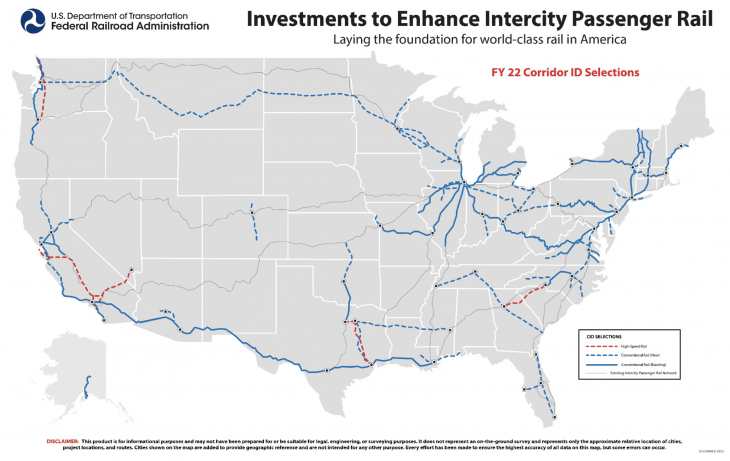Happening Now
Statement on Fed-State and Corridor ID Grants
December 8, 2023
For Immediate Release (23-11)
Contact: M. Ned Butler ([email protected])
Communications Manager
Rail Passengers Applaud Release of Bipartisan Infrastructure Law Rail Funds
The U.S. Department of Transportation announced major advancements in two important passenger rail programs this week, quickening the pace of implementation for the Bipartisan Infrastructure Law. First, the Federal Railroad Administration (FRA) released $8.1 billion in funding commitments for 10 passenger rail projects across the U.S., including large funding agreements for two high-speed rail projects. Simultaneously, the FRA revealed the inaugural Corridor Identification Program (Corridor ID) list, selecting 69 routes across the U.S. to receive planning and service development funding.
"Passengers from across America will be thrilled to read about the funding agreements announced today by the Biden-Harris Administration,” said Jim Mathews, President and CEO of the Rail Passengers Association. “These grants will support the introduction of daily Amtrak service in regions that currently have to make do with trains that only come through their town three times per week; they will help expand popular Amtrak services in rapidly growing parts of the Southeast; and they’ll plant the seeds for scores of new routes across the nation. A successful federal passenger rail program must do more than improve the commutes in coastal cities—investing in an improved and expanded Amtrak is the surest way to ensure that the Bipartisan Infrastructure Law improves the transportation network for all Americans."
The $8.1 billion grabbed the headlines, with major grants announced for the Central Valley section of the California high-speed rail system, the Brightline West project from Las Vegas to Southern California, and the Washington, D.C. - Richmond, VA - Raleigh, NC corridor. Today’s announcement includes $4.5 billion in FY22 and FY23 grants from the Federal - State Program for Intercity Passenger Rail (Fed-State), along with with contingent commitments from future years of BIL funding.
While it includes less money, the Corridor ID announcements may ultimately play a greater role in shaping the future of the U.S. rail network. The $500,000 planning and service development grants were distributed to 69 routes across the U.S., with funding spread into four categories: new high-speed rail corridors, new conventional rail corridors, existing routes with extensions, and existing routes. These grants will speed the development of new services on routes that haven’t performed the required permitting or done sufficient design and engineering work to start construction.
Corridor ID will play an important role for regions who look at today's announcement and feel left out. There were several key corridors that either didn't receive Fed-State grants to begin engineering and construction -- such as the Houston - Dallas high-speed rail line and the Heartland Flyer Extension -- or were left off of the Corridor ID list -- such as the Pioneer restoration between Salt Lake City, Boise, and Seattle. Corridor ID will act as a pipeline for developing projects. It will help advance routes to a stage where they are ready to break ground, while maintaining the ability to add additional corridors to the pipeline in future iterations.
[Click here for a full list of Corridor ID grants.]
###
About Rail Passengers Association:
Rail Passengers Association is the leading voice for the more than 40 million rail passengers in the United States. We are a non-profit organization fighting for a modern and robust national rail network that delivers safe, efficient, and affordable rail travel for all passengers. By mobilizing a grassroots network of rail advocates, we work to improve and expand conventional intercity and regional passenger train services, support higher speed rail initiatives, increase connectivity among all forms of transportation and ensure safety for our country's trains and passengers. All of this makes communities safer, more accessible, and more productive, improving the lives of everyone who lives, works, and plays in towns all across America.
"The support from the Rail Passengers Association, and from all of you individually, has been incredibly important to Amtrak throughout our history and especially so during the last trying year."
Bill Flynn, Amtrak CEO
April 19, 2021, speaking to attendees at the Rail Passengers Virtual Spring Advocacy Conference

Comments